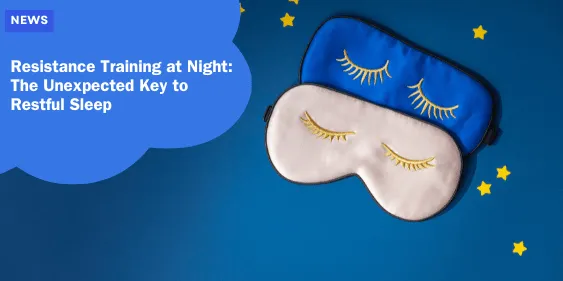Resistance Training at Night: The Unexpected Key to Restful Sleep

Prevalence of Sleep Issues in Adults
One of the most pervasive health concerns today involves sleep, or more precisely, the lack thereof.
In the United States alone, sleep issues affect a significant portion of the adult population. According to a 2022 survey, about 39% of adults aged 45 to 64 report not getting enough sleep.
This prevalence of sleep issues highlights an urgent need for effective, accessible solutions.
Traditional Advice Discourages Evening Exercise
For years, conventional wisdom has advised against exercising in the evening.
The thinking goes that physical activity can elevate your heart rate and body temperature, making it harder to wind down and fall asleep.
Many health experts have recommended that any vigorous exercise be completed at least two to three hours before bedtime to avoid potential sleep disruptions.
New Study Suggests Evening Resistance Training May Improve Sleep
But what if the traditional advice has been missing the mark? A study conducted by researchers at the University of Otago in New Zealand introduces a novel and counterintuitive idea: evening exercise, specifically resistance training, might actually improve sleep.
This small-scale study involved 28 female nonsmokers who typically experienced prolonged sitting during their workday.
Participants incorporated three-minute bouts of resistance exercise every 30 minutes over a four-hour evening period.
Surprisingly, the findings revealed that participants who engaged in these mini-workouts slept an average of 27.7 minutes longer than those who remained seated.
By challenging long-held beliefs about evening exercise and sleep, this new research opens up exciting possibilities for those struggling with sleep issues.
Rather than avoiding evening exercise altogether, it may be more about engaging in the right types of activity.
This fresh perspective could shift how we think about pre-bedtime routines, offering a simple, practical solution for better sleep.
The Groundbreaking Study
University of Otago’s Research
A groundbreaking study by researchers from the University of Otago in New Zealand has revealed remarkable findings about evening resistance training and its effect on sleep.
The study involved 28 healthy female nonsmokers who typically experienced prolonged periods of sitting during the workday and evening.
To explore the influence of evening exercise, these participants were monitored in a supervised lab setting where they either engaged in regular exercise breaks or remained seated.
Exercise Breaks and Key Findings
The design of the study was simple yet innovative.
Participants took three-minute breaks every half-hour over a four-hour evening period, performing light-intensity resistance exercises such as chair squats and calf raises.
The results were compelling: those who participated in these evening exercise breaks slept an average of 27.7 minutes longer than those who remained inactive.
Challenging Traditional Advice
This finding was surprising, especially given traditional sleep hygiene guidelines that discourage evening exercise due to concerns that it might disrupt sleep by increasing body temperature and heart rate.
However, the study demonstrated that brief, low-intensity exercises did not negatively impact sleep efficiency or cause more awakenings.
Instead, they significantly improved sleep duration without disrupting other aspects of sleep quality.
A New Perspective on Exercise and Sleep
Lead author Jennifer Gale emphasized that the key might lie in the nature and timing of the exercise.
The study’s brief and less-intense exercises likely didn’t elevate body temperature or heart rate enough to interfere with sleep, thereby challenging the conventional wisdom about evening exercise.
The intriguing results from this study have opened up new avenues for improving sleep through manageable evening physical activity, pointing towards the broader implications for those with sedentary lifestyles.
Understanding Resistance Training
Definition of Resistance Training
Resistance training, also known as strength training, involves exercises that cause muscles to contract against an external resistance.
This could be through your own body weight, free weights, resistance bands, or machines.
The goal is to challenge your muscles, encouraging them to grow stronger over time.
Examples of Resistance Exercises
There are numerous exercises that fall under the category of resistance training. Some simple yet effective examples include:
- Push-ups: A classic exercise that uses body weight as resistance, targeting the chest, shoulders, and triceps.
- Squats: Another body weight exercise focusing on the legs and glutes. Variations include chair squats, which were used in the study.
- Calf Raises: Involves rising onto the toes and lowering back down, strengthening the calves. This exercise was also used in the study.
- Resistance Band Exercises: Bands can be used for various exercises like bicep curls or leg extensions, providing adjustable levels of resistance.
- Weight Lifting: Free weights or machines can be used to perform exercises like deadlifts, bench presses, and rows.
Benefits Beyond Sleep Improvement
While the University of Otago study highlighted the surprising sleep benefits of evening resistance training, it’s worth noting the broader range of health advantages:
- Improved Muscle Strength and Endurance: Engaging in resistance training consistently helps build muscle strength and endurance, making daily tasks easier.
- Enhanced Metabolic Rate: Muscles require more energy, so increasing muscle mass can boost your metabolism, aiding in weight management.
- Bone Density Improvement: Resistance exercises apply stress to bones, which can increase bone density and reduce the risk of osteoporosis.
- Elevated Mood and Energy Levels: Physical activity, including resistance training, stimulates the release of endorphins, enhancing mood and energy levels.
- Support for Healthy Aging: Maintaining muscle mass and strength is crucial for independence and quality of life as you age.
Understanding these foundational aspects of resistance training sets the stage for appreciating how it can be strategically used to enhance sleep quality and overall health.
The Science Behind Evening Exercise and Sleep
Brief, Low-Intensity Exercises Don’t Disrupt Sleep
Evening resistance training, contrary to long-held beliefs, does not necessarily disrupt sleep.
Traditional advice has often cautioned against exercising close to bedtime, owing to concerns that vigorous activity might elevate heart rate and body temperature.
However, recent findings from the University of Otago turn this notion on its head.
Researchers observed that short, low-intensity exercise breaks, such as chair squats, calf raises, and standing knee raises with hip extensions, actually led to a significant increase in sleep duration without causing any adverse effects on sleep quality.
Participants in the study did not experience increased wakefulness or decreased sleep efficiency.
This indicates that not all evening exercise is detrimental; the key lies in the intensity and duration of the activities.
Contrast with Traditional Beliefs About Pre-Bedtime Exercise
Traditional sleep advice has often warned against intense workouts close to bedtime, typically recommending a buffer period of up to two hours between exercise and sleep.
The concern has been that increased physical exertion can raise core body temperature and heart rate, making it difficult to fall asleep. However, the University of Otago study suggests that this blanket recommendation may need refinement.
The low-intensity exercises implemented in the study did not elevate the participants’ heart rates or body temperatures to levels that disrupt sleep.
Instead, the structured and moderate nature of these exercise breaks offered a more conducive pathway to restful sleep.
This finding challenges the generalized sleep hygiene guidelines and opens avenues for rethinking evening routines.
Potential Mechanisms for Improved Sleep
The mechanisms through which evening resistance training enhances sleep are not yet fully understood, but several theories are emerging. One hypothesis is that such exercises help to counteract the negative effects of prolonged sitting and sedentary behavior, which are known to interfere with sleep quality.
By incorporating short bursts of physical activity, individuals may be able to mitigate these effects, thereby improving overall sleep outcomes.
Another potential mechanism involves the role of exercise in stress management.
Low-intensity physical activities can promote relaxation and reduce stress levels, making it easier for individuals to transition into a restful state.
Additionally, the modest increase in physical exertion from these short exercise breaks may promote muscle relaxation, further facilitating better sleep.
By integrating brief and controlled exercise sessions into the evening routine, individuals are not only able to extend their sleep duration but also improve sleep quality without the risks associated with more intense pre-bedtime workouts.
This newfound understanding paves the way for practical sleep solutions that can easily fit into anyone’s daily schedule.
Implementing Evening Exercise Breaks
Specific Exercises Used in the Study
The groundbreaking study by the University of Otago focused on three specific exercises, all of which can be easily done at home without specialized equipment:
- Chair Squats: These involve standing up from a seated position without using your hands and then sitting back down, repeating the process for 20 seconds. This helps strengthen your leg muscles.
- Calf Raises: In a standing position, rise onto your toes and then lower back down, repeating for 20 seconds. This exercise targets the calf muscles and helps improve balance.
- Standing Knee Raises with Straight-Leg Hip Extensions: Alternate lifting each knee toward your chest, followed by extending your leg back, for 20 seconds each. For balance, use the back of a chair or wall.
Alternative Exercises for Variety
To keep your routine interesting and avoid monotony, consider these alternative exercises:
- Marching in Place: Lift your knees alternately to hip height while swinging your arms, repeating for 20 seconds. This exercise mimics walking and helps in overall leg muscle activation.
- Wall Push-Ups: Stand facing a wall, place your hands on the wall at shoulder height with arms straight and palms down, and perform push-ups against the wall for 20 seconds. This targets the upper body muscles without the intensity of a traditional push-up.
- Seated Leg Lifts: Sit on a chair and lift one leg straight out, hold for a few seconds, and then lower it. Alternate legs and repeat for 20 seconds.
Tips for Incorporating into Daily Routine
Adding these exercises to your evening routine can be simple and effective. Here are some tips to help you get started:
- Set Reminders: Use a timer or app to remind you to take exercise breaks every 30 minutes during the evening.
- Keep it Simple: Opt for exercises that do not require much space or equipment.
- Listen to Your Body: Adjust the intensity and duration according to your comfort and fitness level. Start slow and gradually increase as you get more comfortable.
- Consistency is Key: Make it a habit by integrating these exercises into your daily routine. Consistency will yield better results over time.
By following these tips, you can seamlessly incorporate evening exercise breaks into your routine, potentially improving both your sleep quality and overall well-being.
Potential Impact and Future Research
Implications for Individuals with Sedentary Lifestyles
For those with a sedentary lifestyle, integrating brief, light-intensity evening resistance exercises could be a game changer.
Often, the need for extended periods of sitting, whether due to work or other commitments, is unavoidable.
However, this study indicates that breaking up these prolonged sitting sessions with resistance exercises can significantly improve sleep quality.
This method is particularly appealing because it requires minimal time and no special equipment, making it accessible to almost everyone.
Ongoing Research on Real-World Implementation
Researchers from the University of Otago are not stopping with their initial findings.
They are conducting a follow-up pilot study to determine how best to support individuals in incorporating these sleep-improving exercises into their evening routines in a real-world setting.
This ongoing research aims to develop practical strategies and guidelines that people can easily incorporate into their lives, ensuring consistency and effectiveness.
Potential for Transforming Pre-Bedtime Routines
The potential to transform pre-bedtime routines is immense.
Traditional sleep advice often emphasizes winding down and avoiding physical activity close to bedtime.
However, this new approach encourages short bursts of activity, challenging conventional wisdom.
By redefining what we consider pre-sleep activities, we can create routines that not only help us unwind but also set us up for a better night’s sleep.
Integrating these insights into daily habits could pave the way for a revolutionary shift in how we approach both exercise and sleep.
Conclusion: A Simple Solution for Better Sleep
The University of Otago’s study has provided a refreshing perspective on evening routines by showing the unexpected sleep benefits of low-intensity resistance training.
With participants sleeping an average of 27.7 minutes longer, this simple intervention could be a game-changer for those struggling to get enough rest.
Unexpected Benefits
The discovery that brief, low-intensity resistance exercises can enhance sleep without disrupting its quality is a significant shift from traditional advice.
These activities, such as chair squats and calf raises, are accessible to most people, requiring no special equipment or strenuous effort.
It flips the traditional idea of evening exercise on its head, suggesting that even those with busy schedules or less active lifestyles can find a way to improve their sleep quality in a simple, effective manner.
Encouragement to Try the New Approach
Given these compelling findings, why not experiment with incorporating these brief exercise breaks into your evening routine? It’s an easy and practical step towards better sleep and overall health.
Whether you choose chair squats, wall push-ups, or calf raises, the activities are straightforward and require minimal time commitment.
The positive impact on your sleep could enhance your energy levels, mood, and overall quality of life.
Emphasizing Simplicity and Accessibility
The brilliance of this approach lies in its simplicity and accessibility.
You don’t need to change your entire lifestyle or commit to lengthy exercise sessions.
A few minutes of targeted exercises in the evening can yield significant benefits.
These exercises are easy to perform and adapt to any fitness level, making them a realistic option for a wide range of individuals.
By taking these small steps, you may find that better sleep is within your reach, transforming not only your nights but also your days.






